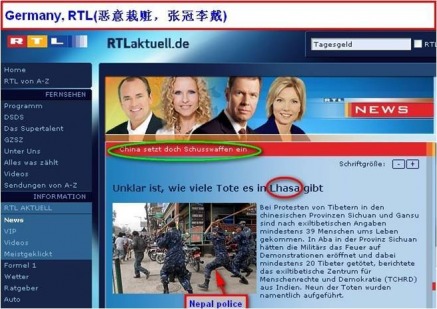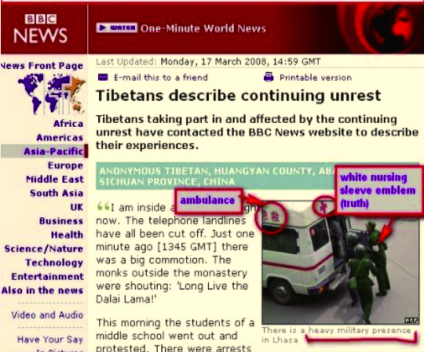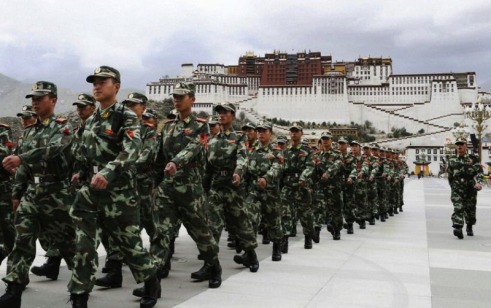How do Chinese and Western media view China-Tibet relation?
Diverge: Riot on March 14, 2008
2008 Tibetan Unrest: Western media's version
The 2008 Tibetan unrest was a series of riots and demonstrations in the TAR. The unrest began with demonstrations on March 10, 2008, the 49th anniversary of the failed uprising in 1959 in Tibet against Beijing's rule. The events began when hundreds of monks from Lhasa's Drepung monastery began peaceful protests calling for the release of other monks detained since the previous autumn. Within a week, violence sprang up [1]. Tibetans attacked non-Tibetan ethnic groups [2]. Rioting, burning, looting and killing began on March 14.[3]
Some Western Media reported that this riot was caused by increasing socio-economic issues in Lhasa. Tibetans in Lhasa were angered by inflation that has caused the prices of food and consumer goods to increase and The Tibetan youth complained about not having equal access to jobs and education. James Miles, The Economist’ reporter and the only foreign reporter allowed to enter TAR during riots, hold that 3.14 riot was an “eruption of ethnic hatred” [3]
Some Western Media reported that this riot was caused by increasing socio-economic issues in Lhasa. Tibetans in Lhasa were angered by inflation that has caused the prices of food and consumer goods to increase and The Tibetan youth complained about not having equal access to jobs and education. James Miles, The Economist’ reporter and the only foreign reporter allowed to enter TAR during riots, hold that 3.14 riot was an “eruption of ethnic hatred” [3]
2008 3. 14 Riot: Chinese media's version
Facing with the global criticism for its sending of troops to Tibet to crack down on the protests, Beijing conducted its own attacks to Western media. The state media, CCTV, have repeatedly broadcast videos of Tibetans burning Chinese shops. State newspapers have been filled with accounts of innocent Han Chinese killed in Lhasa by rampaging Tibetans [4]. Stories such as the burning to death of five young girls successfully persuaded domestic people to believe that such event was race riot rather than peaceful demonstration. China Daily pointed out the lack of justice in Western media’s coverage on this riot, including deliberate mis-presentation of the situation [1] [5]. Another main focus of China media’s propaganda was aimed at persuading the public that it was Dalai Lama that organized the violence in 14 March.
International Reaction
Protests were hold in Austria, France, Germany, Italy, United Kingdom and Greek. The main focuses of these pro-Tibet protesters were the Embassy of China and Olympic-related ceremonies. For example, On March 24, 2008, during the Olympic torch lighting ceremony in Olympia, a Tibetan woman covered herself with red paint and lay on the ground, forcing torchbearers to weave around her as other protesters shouted "Flame of shame." Protests were also widespread in major cities in North America. Beginning on March 10, many Tibetans protested in front of China Embassy Washington DC, New York City, San Francisco, Ottawa and Toronto[1].
As for the Olympic boycott, some athletes were considering boycotting the 2008 Summer Olympics in August over the crackdown in Tibet but were advised to still compete. The Olympic Committees voiced opposition to a boycott of the Beijing Games over China's handling of the Tibet protests, saying sports should not be linked to politics [1].
As for the Olympic boycott, some athletes were considering boycotting the 2008 Summer Olympics in August over the crackdown in Tibet but were advised to still compete. The Olympic Committees voiced opposition to a boycott of the Beijing Games over China's handling of the Tibet protests, saying sports should not be linked to politics [1].
Focus on Media Bias
This section will serve as an example to show how politics, ideology and stereotypes result in media bias, both in Chinese and Western sides. As we have discussed in last section “diverge: 50 years”, the Western medias have long believed that non-violent protests in Tibet have been crushed with cruel repression. Long years in prison and even death penalty are the fate of the Tibetans caught in a protest. Holding such viewpoints, the Western media is reluctant to realize or to tell its readers how violent the protest happening in 14 March 2008 was. In order to serve its purpose, some strategies are being used to distract readers from the facts of violence and instead emphasize how brutal the Chinese government’s repression is.
For example, BBC reported that Tibetan sources say that as many as 80 people were killed during the unrest, though Chinese authorities said just 10 people had died. It is highly possible that Chinese government understated the number of people killed, in order to keep the “stability” of the whole society. Let’s assume that Tibetan sources told the truth. What’s more important, however, BBC did not articulate that why those 80 people died? Were they killed by Chinese police or by the mob? Were these people the mob or common people who happened to pass by? No matter what the truth is, the only impression given by BBC’s report is that Chinese authorities again told the lie. Such reports, aiming at enforcing the stereotypes, failed to achieve the goal of giving compete truth instead of only parts of truth. Some time, parts of the truth are more misleading than the lies.
Besides shaping its tones and narratives carefully, some Western Medias even distort the facts deliberately. The following pictures on New York Times, Washington Post and RTL try to show how brutal “Chinese police” is while the people in the picture are actually Nepal police. (One can identify it from the uniform the police wear. The last picture shows waht kind of uniform the Chinese police wear
For example, BBC reported that Tibetan sources say that as many as 80 people were killed during the unrest, though Chinese authorities said just 10 people had died. It is highly possible that Chinese government understated the number of people killed, in order to keep the “stability” of the whole society. Let’s assume that Tibetan sources told the truth. What’s more important, however, BBC did not articulate that why those 80 people died? Were they killed by Chinese police or by the mob? Were these people the mob or common people who happened to pass by? No matter what the truth is, the only impression given by BBC’s report is that Chinese authorities again told the lie. Such reports, aiming at enforcing the stereotypes, failed to achieve the goal of giving compete truth instead of only parts of truth. Some time, parts of the truth are more misleading than the lies.
Besides shaping its tones and narratives carefully, some Western Medias even distort the facts deliberately. The following pictures on New York Times, Washington Post and RTL try to show how brutal “Chinese police” is while the people in the picture are actually Nepal police. (One can identify it from the uniform the police wear. The last picture shows waht kind of uniform the Chinese police wear
Many people will only browse the pictures on newspaper and the caption under the newspaper instead of reading the whole article. From that sense, the following picture is very misleading. The captain under the picture says that “There is a heavy military presence in Lhasa” and the picture simply shows people wearing military uniform, giving readers the impression that heavy military were used for repression. However, it is not hard to identify the “red cross” in picture, which reveals that those people, instead of being a part of repression force, were actually saving the injured person.
Chinese media, putting too much attention on criticizing Western media, neglects that BBC’s description that “heavy military in Tibet” may be correct despite of the fact that it used an improper photo. The picture below may serve as a good choice of BBC.
Then, what is the strategy of China on this propaganda? The answer is a blackout over news from Tibet. This is why many people in North America and Europe have not heard about continuing sporadic protests by Buddhist monks in eastern Tibet or reports on the arrests by Chinese police [6]. Along with this blackout, Chinese government also blocked foreign broadcasters and websites access to areas of unrest, including You Tube and The Times [1]. Only allowing its people to listen to one voice from the state media, China hopes the public to achieve consensus and then achieve one of the most important goals: the stability in Chinese society. Globalization, especially in the area of technical communication, offers the world a great opportunity to embrace the views from different resources. Chinese government, however, simply counters this trend and isolates its people in the island of increasingly extreme nationalism. Criticizing loudly at the Western media’s bias, China itself created an even greater bias. From that sense, it is good to know that several weeks after the riots foreign journalists were allowed to access the region again to counteract what the Chinese government called biased Western reporting.
[1] http://en.wikipedia.org/wiki/2008_Tibetan_unrest
[2] China’s forbidden zones
[3] "Fire on the roof of the world". The Economist. March 14, 2008
[4]China and Tibet: The Spin Campaign by Simon Elegant/Beijing Wednesday, Mar. 26, 2008 time
[5]Pressed Over Tibet, China Berates Foreign Media by DAVID BARBOZA, New York Time
[6] Spotlight on China, darkness in Tibet, by Dan Southerland / June 11, 2008. From CSmonitor.com
[2] China’s forbidden zones
[3] "Fire on the roof of the world". The Economist. March 14, 2008
[4]China and Tibet: The Spin Campaign by Simon Elegant/Beijing Wednesday, Mar. 26, 2008 time
[5]Pressed Over Tibet, China Berates Foreign Media by DAVID BARBOZA, New York Time
[6] Spotlight on China, darkness in Tibet, by Dan Southerland / June 11, 2008. From CSmonitor.com





